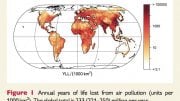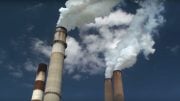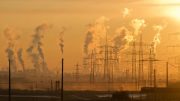
Air pollution refers to the presence of harmful substances, such as gases, particulates, and biological molecules, in the Earth’s atmosphere. Air pollution can have serious negative impacts on human health, as well as the environment. It has been linked to a wide range of health problems, including respiratory and cardiovascular disease, cancer, and other illnesses.
According to the study, fine particulate matter is responsible for an additional 1.5 million premature deaths each year.
According to the World Health Organization, over 4.2 million people die prematurely each year due to long-term exposure to fine particulate outdoor air pollution, also known as PM2.5. However, a recent study involving researchers from McGill University suggests that this number may be underestimated. The study found that mortality risk was increased even at very low levels of PM2.5, levels that were previously not considered dangerous. These microscopic toxins can cause a variety of cardiovascular and respiratory diseases, as well as cancers.
“We found that outdoor PM2.5 may be responsible for as many as 1.5 million additional deaths around the globe each year because of effects at very low concentrations that were not previously appreciated,” said Scott Weichenthal, an Associate Professor in the Department of Epidemiology, Biostatistics, and Occupational Health at McGill University and the lead author on the recent paper in Science Advances.
Canadian data leads to advances in global understanding of the effects of outdoor pollution
The researchers arrived at this conclusion by combining health and mortality data for seven million Canadians gathered over a twenty-five-year period with information about the levels of outdoor PM2.5 concentrations across the country. Canada is a country with low levels of outdoor PM2.5, making it the perfect place to study health impacts at low concentrations. Knowledge gained in Canada was then used to update the lower end of the scale that is used to describe how mortality risk changes with outdoor PM2.5 levels. The result? An improved understanding of how air pollution impacts health on a global scale.
The WHO recently set out ambitious new guidelines for annual average outdoor fine particulate air pollution, cutting its earlier recommendations in half, from concentrations of 10 to concentrations of 5 micrograms (ug) per cubic meter. The current United States Environmental Protection Agency standard of 12 (ug) per cubic meter is now more than double the value recommended by the WHO.
“One takeaway is that the global health benefits of meeting the new WHO guideline are likely much larger than previously assumed,” adds Weichenthal. “The next steps are to stop focussing only on particle mass and start looking more closely at particle composition because some particles are likely more harmful than others. If we can gain a better understanding of this, it may allow us to be much more efficient in designing regulatory interventions to improve population health.”
Reference: “How low can you go? Air pollution affects mortality at very low levels” by Scott Weichenthal, Lauren Pinault, Tanya Christidis, Richard T. Burnett, Jeffrey R. Brook, Yen Chu, Dan L. Crouse, Anders C. Erickson, Perry Hystad, Chi Li, Randall V. Martin, Jun Meng, Amanda J. Pappin, Michael Tjepkema, Aaron van Donkelaar, Crystal L. Weagle and Michael Brauer, 28 September 2022, Science Advances.
DOI: 10.1126/sciadv.abo3381









Consider the source.
I thought the science was settled decades ago. So is the science settled or not?
Why not let go of your dependence on science.
Um, lost me in the first sentence. Headline: “1.5 million premature deaths”. 1st sentence: “4.2 million premature deaths”. You’re writing about science stuff here, pay attention please.
Hello fellow lay readers! The source is Canada and satellite pm2.5 readings plus more. The 4.2 million deaths is the WHO’s call on what we have and this article says nah, 1.5 million more than that bc. look how many excess deaths from it we have where it’s supposedly nice out. But they still have PM 2.5 around. Go over the charts etc. compare to you know, interior PM 2.5 not from smoking if you can, go nuts. But have another method than huffing air sample preticipate discs, because maybe that’s more lethal than sensual.
MOst comes from firewood smoke , doesn’t it?
Too many people BURNING LOGS
Excess deaths from what?
From a “medical procedure”?
Globalist elites such as WEF have talked about de populating for decades. So is this not there wish?
*their*
Thank god salt lake city has the purest air there is.
Has God forsaken everywhere else?